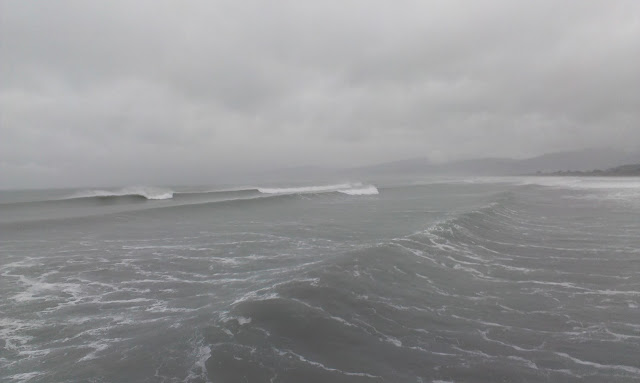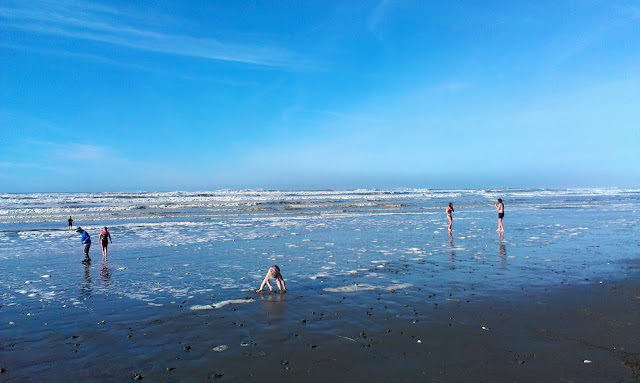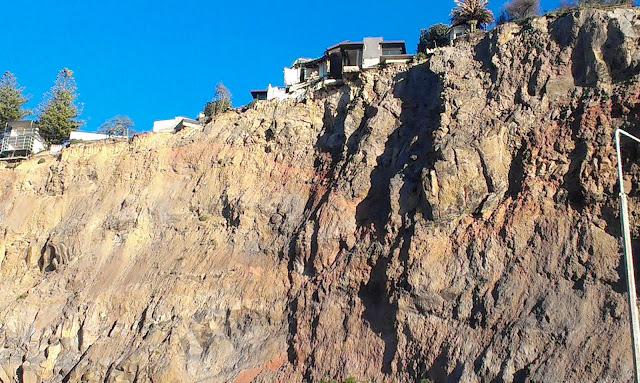Turns out to be not very little at all. We drive down the day before planning to stop the night in Geraldine, but also to meet up with Brahm, Mike's old work buddy, for lunch who's living and working in Timaru. We've passed through Geraldine before but not stayed there and the Backpackers turns out to be pretty good, converted from an old maternity hospital.
| Mike and Paul beside a stream at the foot of the mountain |
We set off pretty early and the weather's not looking too bad though there's a chance of rain later on. Before we start the walk we bump into Paul, a Kiwi tramper, who's doing the same as us but planning to go up the longer 'more interesting' way. He obviously has a lot of experience and certainly looks like he knows what he's doing so we join forces with him.
| Following the ridge up to the peak, still visible before the cloud arrives |
He leads us over and along streams right at the start of the walk and I begin to wonder if we've done the right thing. However he's a nice chap and he likes to talk but has difficulty walking and talking at the same time, so there are a lot of rather unnecessary stops and all the time the clouds are gathering as the weather begins to turn.
| Looking through the flax back across the Canterbury plains |
We know it's a long walk. The DOC boards say 3.5 hours up the long way and 2.5 the quick route. We eventually climb out onto a ridge, walking through huge clumps of flax and spiky Spaniard. Initially we can see the top of the mountain but as we get closer, thick grey cloud floods in over the saddle and envelops the peak. The track itself is pretty clear but not at all easy, involving some huge leg-stretching steps and, towards the top, some rock climbing. 'Nothing difficult, so long as you maintain 3 points of contact at all times' says Paul. By this time I'm really tired and the slight drizzle turns into rain. At the top we can't see anything at all.
| Following Paul up the rock face, Mike behind ready to catch me |
We have lunch in the hut just below the summit then begin the descent down the 'easy' path. To begin with there are a lot of board walk steps and as they're wet we really have to concentrate. It's certainly quicker going down but still takes about 2 hours, so just over 6 hours in total. We are wet through and I have to pour the water out of my boots. It takes 4 days for my legs to recover, but I'm quite proud of myself, good practice for the Routeburn!
Mount Grey, 15 December
| Huge flax surround the pool with dragon flies skimming the surface |
Not such a high mountain, this one, so should be a doddle after Mt Peel, but it's a very warm day so could be a struggle. We start off planning to do the Grey River Nature Trail, and are definitely on the right road, but somehow we miss that and end up at the foot of the Mt Grey trail. Just as we're having a look around the lake at the start of the walk, 5 or 6 other cars arrive altogether, planning to climb the mountain, so we do it too.
| Fabulous foxglove path |
Starts off through a lovely shady pine forest and then as we come out into the dappled sunlight we find ourselves on the most gorgeous woodland trail edged by huge quantities of foxgloves. The path continues upwards eventually coming out into full sun as the upper part of the mountain is covered with broom and manuka. We're getting pretty hot but the lookout is within sight and when we get up there I sit for a long time in the cool shade before heading back down the same way.
| Looking through the flax northwards |
Just a short walk, 2 hours at most so we go to Amberley for lunch, take a look at the local beach and make our way home.













